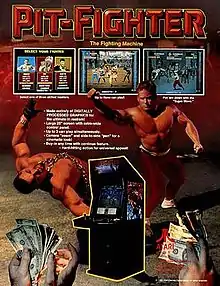Pit-Fighter
Pit-Fighter is a 1990 arcade fighting game by Atari Games which used digitized live actors. The Japanese arcade release was published by Konami. Home versions were published by Tengen.
| Pit-Fighter | |
|---|---|
 | |
| Developer(s) | Atari Games |
| Publisher(s) | Atari Games Tengen Konami (Japan) |
| Designer(s) | Gary Stark Mark Pierce |
| Programmer(s) | Gary Stark Paul Kwinn |
| Artist(s) | Rob Rowe |
| Composer(s) | John Paul |
| Platform(s) | Arcade, Amiga, Amstrad CPC, Atari ST, Commodore 64, MS-DOS, Game Boy, Lynx, Master System, Genesis, SNES, ZX Spectrum |
| Release | |
| Genre(s) | Fighting |
| Mode(s) | Up to 3 players simultaneously |
| Arcade system | Atari G1 Hardware |
The graphical animations for the player character and opponents were created through a bluescreen process, where the various poses and moves were performed by real actors in front of a video camera. The game's on-screen character animation are replays of the actual footage, not a rotoscoped (redrawn) animation. Pit-Fighter is the second fighting game to use digitized sprites, after Home Data's Reikai Dōshi: Chinese Exorcist.
Gameplay
The gameplay is similar to Taito's Violence Fight and SNK's Street Smart. The player must punch and kick their opponents until their energy runs out. If the player presses all three of the buttons at once, the character will perform a "super move". The player begins by choosing one of the three playable characters, who each have different moves, speed, and power. As many as three people can play at a time, but there will be extra opponents to fight during any of the game's 15 different matches.
Every third fight is a bonus round known as a Grudge Match.[2] In a Grudge Match, the player must fight against a CPU controlled clone of the fighter if playing alone, or against the other players in a multiplayer game. Getting knocked down three times eliminates a player from the Grudge Match, the winner is the last one standing. Losing the Grudge Match does not eliminate a player, but the winner gets bonus money.
The final battle, the "Championship Match", is between the player and the mysterious entity that taunts between matches periodically, the Masked Warrior. If more than one person is playing the game before this match, they must fight each other to the death until only one becomes victorious and can fight him.
Sometimes during matches the player will encounter foreign objects such as knives, crates, sticks, motorcycles, and bar stools that can be thrown at a character in play. The player may also encounter a power-up known as the "power pill". If a character grabs this item, one will become temporarily stronger and take less damage from hits.
At times even the crowd will interfere in the fights. Two characters, known as Knife Man (Milt Loper) and Knife Woman (Dianne Bertucci), will come out of the crowd and stab the player with their daggers. The player can take these nuisances out with one hit. Sometimes there is also a fat bearded man with a stick. If the player knocks him down, the player can take the stick and use it against the current opponent.
The audience will also push any fighter that ends up among them, and stays there more than a few seconds. They will be forced back into the fighting area.
Characters
Pit-Fighter features 3 playable fighters:
- Buzz (Bill Chase): A big and strong ex-professional wrestler.
- Ty (Marc Williams): An agile kickboxing champion.
- Kato (Glenn Fratticelli): A quick 3rd degree black belt.
Pit-Fighter has 8 unplayable opponents. Several of the characters share the names of the actors who played them:[3]
- Executioner (John Aguire)
- Southside Jim (James Thompson)
- Angel (Angela Stellato)
- C.C. Rider (Rich Vargas)
- Mad Miles (Miles McGowan)
- Heavy Metal (Kim Rhodes)
- Chainman Eddie (Eddie Venancio)
- Masked Warrior (Bill McAleenan)
Others:
- Knife Woman (Dianne Bertucci)
- Knife Man (Milt Loper)
- Finale Woman (Tina Scyrater)
- Finale Woman (Maria Lenytzkyj)
- Big Kid In The Crowd (Gabriel Koura)
- Crowd (Rob Rowe)
Ports
Ports of the game were released for the Super NES, Mega Drive/Genesis, and Sega Master System in 1991. Ports were also released in 1991 for personal computers: the Amiga, Amstrad CPC, Atari ST, Commodore 64, MS-DOS, ZX Spectrum. In February 1993, the Spectrum version was released as part of the Super Fighter compilation with Final Fight and WWF WrestleMania.[4] MegaTech magazine said the graphics were "badly defined with rough animation". Mega placed the Mega Drive version at #27 in their Top Mega Drive Games of All Time.[5] The Super NES port lacks the interactive audience and weapons, and is missing three characters: Southside Jim, Heavy Metal, and Mad Miles.
Handheld versions were released for the Atari Lynx and the Game Boy in 1992. Tiger Electronics released its own dedicated handheld version of the game.
An emulated version of the arcade game is featured in the 2004's Midway Arcade Treasures 2 for GameCube, PlayStation 2, and Xbox, as well as Midway Arcade Treasures Deluxe Edition (2006) for Microsoft Windows. This version runs at a faster speed than the arcade original. Pit-Fighter was also included in the 2012 compilation Midway Arcade Origins.[6]
Reception
In Japan, Game Machine listed Pit-Fighter on their January 1, 1991 issue as being the seventh most-successful table arcade unit of the year.[8]
Julian Rignall of Computer and Video Games gave the game 90%, calling it a "thoroughly enjoyable beat'em up which really packs a punch" and "one of the most enjoyable arcade fighting games in a long time."[9] Zzap!64 gave the game a more negative review, dubbing it an "anticlimactic beat'em up" and writing that the attract mode was the best part of the game. They criticized the limited frames of animation and compared it unfavorably to The Combatribes and Final Fight.[10]
Computer Gaming World approved of the Amiga version of Pit-Fighter, stating that it "is the arcade game teleported", and concluded that the game "offers the two-player option missing in many fighter games and enough roughhousing to suit the most violent gamer".[11]
Reviewing the Super Nintendo port, George and Rob reviewed the game in Nintendo Power.[12] George commented that game was "extremely difficult to control" and that Rob commented on the graphics using digitized people, stating "it doesn't matter if it uses new technology or not. The question is "is the game fun?" and I think the answer in this case is "no"."[12]
Legacy
Electronic Gaming Monthly and GamePro had previews of a planned sequel, which the former magazine claimed was more than 75% finished and would be released for Sega Genesis in the 4th quarter of 1993.[13][14] Kato, Buzz, and Ty were returning along with three new selectable fighters: Connor (Karate Champion), Tanya (Roller Queen), and Chief (Ex-bodyguard) — three of the playable characters that were ultimately featured in Atari's subsequent game, Guardians of the 'Hood. Pictures show two CPU fighters, Helga (level 1) and Jay-Jay (level 2).
References
- "Pit-Fighter arcade video game by Atari Games Corp. (1990)". Arcade-history.com. Retrieved 2016-10-15.
- "Pit-Fighter". MobyGames. Retrieved 9 Nov 2013.
- https://www.imdb.com/title/tt0296802/fullcredits?ref_=tt_cl_sm#cast
- "Super Fighter". Ysrnry.co.uk. Archived from the original on 2012-08-13. Retrieved 2012-08-10.
- Mega magazine issue 1, page 76, Future Publishing, Oct 1992
- "Midway Arcade Origins Review". IGN. 2012-11-13. Retrieved 2016-10-15.
- MegaTech rating, EMAP, issue 5, page 78, May 1992
- "Game Machine's Best Hit Games 25 - テーブル型TVゲーム機 (Table Videos)". Game Machine (in Japanese). No. 395. Amusement Press, Inc. 1 January 1991. p. 37.
- Rignall, Julian (January 1991). "Pit Fighter". Computer+Video Games: 140. Retrieved 26 March 2018. Cite journal requires
|journal=(help) - "Pit-Fighter". Zzap!64. February 1991: 54. Cite journal requires
|journal=(help) - Wilson, David (October 1992). "Pit-Fighter". Computer Gaming World. p. 66. Retrieved 4 July 2014.
- George; Rob (January 1992). "George & Rob's Now Playing". Nintendo Power. Vol. 32. p. 102.
- Gurka, John (August 1993). "Fact-Files: Pit Fighter II". Electronic Gaming Monthly. No. 49. Sendai Publishing. pp. 126–127.
- "Short ProShots: Genesis". GamePro. No. 51. IDG. October 1993. pp. 148–150.
